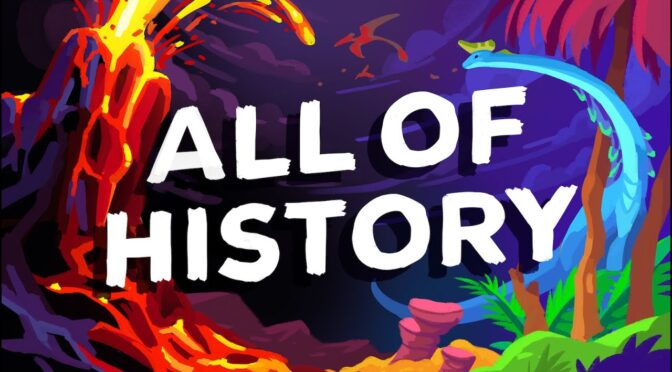This article is based on a video titled “4.5 Billion Years in 1 Hour” by Kurzgesagt – In a Nutshell, offering a unique perspective on Earth’s extensive history. The video compresses Earth’s 4.5 billion-year lifespan into an hour-long visual and auditory experience, providing a sense of the immense scale of geological time.
Contents
- The Hadean Eon – Earth’s Fiery Beginnings
- Emergence of Water and Life
- The Archean Eon – Birth of Continents and Photosynthesis
- The Great Oxidation Event
- The Rise of Complex Life
- The Cambrian Explosion and Beyond
- The Age of Mammals and Human History
- The video
The Hadean Eon – Earth’s Fiery Beginnings
In the Hadean Eon, Earth, newly formed, was a tumultuous world of lava, undergoing dramatic changes including the formation of the Moon following a colossal collision with a Mars-sized object named Theia. This period, characterized by a CO2-rich atmosphere and a molten surface, marks the earliest chapter in Earth’s history, a time when the planet was largely uninhabitable and shrouded in mystery due to the lack of surviving geological evidence.
Emergence of Water and Life
Despite the hostile conditions, the presence of water and the beginnings of life are hinted at during this era. Hydrothermal vents, possibly the cradles of life, emerge in the oceans, setting the stage for the evolution of life. The video suggests that life, in its most primitive form, began to take hold on Earth, thriving in an environment vastly different from today’s world.
The Archean Eon – Birth of Continents and Photosynthesis
As Earth progresses into the Archean Eon, significant developments occur. The formation of continents begins, driven by the movement of tectonic plates. This era also witnesses the advent of photosynthesis, a pivotal process that would eventually lead to the oxygenation of the atmosphere. However, during this time, Earth’s atmosphere is still devoid of oxygen, and the conditions remain inhospitable to modern life forms.
The Great Oxidation Event
The transition to the Proterozoic Eon brings one of Earth’s most transformative events: the Great Oxidation Event. Cyanobacteria, through photosynthesis, release large quantities of oxygen into the atmosphere, fundamentally altering the planet’s chemistry and paving the way for more complex life forms. This period also sees the planet’s first severe ice ages, triggered by the newly oxygenated atmosphere.
The Rise of Complex Life
As Earth continues to evolve, the video highlights the emergence of eukaryotic cells, organisms with a nucleus, which represent a major leap in the complexity of life. The formation of Earth’s inner core and the advent of sexual reproduction in certain organisms further illustrate the dynamic changes occurring over billions of years.
The Cambrian Explosion and Beyond
The Cambrian Explosion marks a period of rapid diversification in life, with the appearance of many major animal groups. This era of flourishing life is followed by mass extinctions and the spread of plants on land, which reshape the planet’s surface and atmosphere. The rise of forests, the formation of supercontinents, and the dominance of dinosaurs during the Mesozoic Era are all milestones in Earth’s journey.
The Age of Mammals and Human History
The video concludes with the Cretaceous-Paleogene extinction event, which leads to the rise of mammals and eventually humans. This brief period, in the grand scheme of Earth’s history, underscores the relative newness of human existence compared to the vast expanse of geological time.
The video
“4.5 Billion Years in 1 Hour” by Kurzgesagt encapsulates Earth’s extensive and complex history, offering a unique perspective on the passage of time and the evolution of life. The video serves as a reminder of the planet’s ancient past and the fleeting nature of human history within it.

